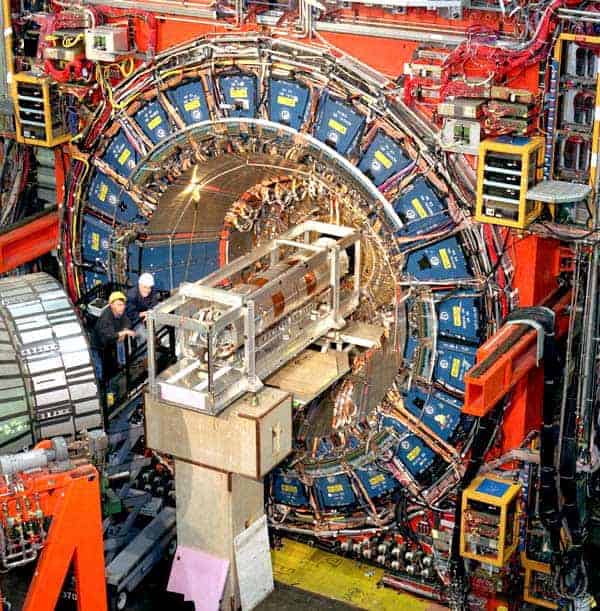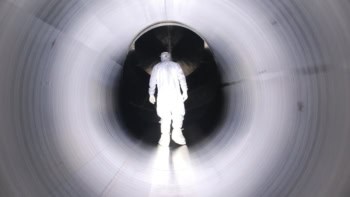
Physicists and dignitaries are gathering at Fermilab on the outskirts of Chicago to mark the final day of collisions at the Tevatron particle collider. The shutdown procedure will begin today at 2 p.m. local time, marking the end of the facility’s 26-year lifetime.
The shutdown comes despite calls to extend operations for a further three years, meaning that the search for the elusive Higgs boson is now likely to become a one-horse race involving the Large Hadron Collider (LHC) at CERN.
Commissioned in 1985, the facility’s achievements include the discovery of the top quark in 1995. This helped the Japanese physicists Makoto Kobayashi and Toshihide Maskawa win the 2008 Nobel Prize in Physics for their prediction of the particle’s existence.
Discoveries kept coming
Other notable discoveries made at the Tevatron are the tau neutrino in 2000; the Bc meson in 1998 and the first sighting of a single top quark in 2009. The collider, which has a circumference of more than six kilometres, also played important roles in the study of CP violation, measuring the mass of the W boson – and more recently, placing constraints on the mass of the Higgs boson.
The Tevatron collides protons with antiprotons at energies as high as 1.96 TeV, which made it the world’s most energetic collider until it was usurped by the LHC in 2009. However, that did not stop physicists working on Tevatron’s two main experiments – CDF and DØ – from churning out interesting results. Earlier this year, for example, particle physicists were buzzing about a mysterious “bump” that was seen in CDF data and could be evidence for a completely new particle.
Tevatron was also a centre of development of new accelerator and detector technology. The collider was the world’s first major accelerator to use superconducting magnets – which allow particles to be accelerated to much higher energies than conventional magnets. During its life time, Tevatron physicists managed to boost the luminosity (collision rate) of the collider to more than 300 times that of the original design.
Accelerator innovations
Fermilab’s director of accelerator physics, Vladimir Shiltsev, puts this and other accelerator-related successes down to a number of key technological developments, including improvements to the Tevatron’s superconducting and permanent magnets; new ways of focusing and collimating the beams; and the development of new methods of high-intensity beam manipulations, which allow physicists to split one bunch of particles into a number of smaller bunches.
On the detector side, Tevatron physicists have pioneered the use of silicon vertex detectors in a hadron collider; played an important role in the development of the ring-imaging Cerenkov counter; as well as making improvements in systems that are used to track particles through the detector.
The Tevatron and its experiments produced about 1400 PhD theses and about one scientific paper per week during its 26 years. CDF and DØ are among the largest scientific collaborations ever, with a paper from either group listing more than 500 authors.
‘Physics by committee’
Although the groups’ successes show that big science can work, not everyone is convinced that “physics by committee” is a good thing. “I’d guess that thing about the Tevatron that captivates me is that no Nobel prizes will likely be awarded for research done at the facility,” says Michael Riordan, a historian of physics at the University of California, Santa Cruz (Kobayashi and Maskawa are theorists who were not involved in the experiments at Tevatron). “The top-quark discovery probably qualifies, but to what three physicists do you award it?” asks Riordan. “Doing physics by committee was a sharp break from what had occurred previously in the United States and had helped it dominate [particle] physics for three decades.”
Riordan is not the only person worried about the future of particle physics in the US. There are currently no plans for a US-based replacement for the Tevatron and all eyes are now on the LHC. While many American physicists are involved in experiments at CERN, the country is not a full member of the lab. As a result, US-based particle physics could be facing a few years in the wilderness. One hope is that the International Linear Collider (ILC) – which is expected to replace the LHC – could be located at Fermilab. However, the ILC promises to be extremely expensive and funding pressures in the US and other countries could mean that the project never gets off the ground.
Meanwhile, at Fermilab, the facility is gearing up for a post-Tevatron world. The ground will soon be broken for the new Illinois Accelerator Research Center, which will see scientists and engineers from Fermilab, Argonne National Lab and Illinois universities working with industrial partners to create new technologies for accelerators.
Audio interview
Chris Quigg speaks to physicsworld.com earlier this year about closing the Tevatron and the future of particle physics in the US:
Tevatron breakthroughs
Tevatron triumphs that have been reported over the years in physicsworld.com:
Tevatron tightens its grip on the Higgs
Top result for Tevatron
Tau neutrino identified at last
Fermilab probes matter-antimatter transitions
New particles turn up in the US
CERN and Fermilab argue over “new” discovery



